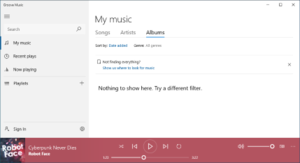Xbox Music
 |
|

Groove Music in Windows 10
|
|
| Opened | October 16, 2012 as Xbox Music |
|---|---|
| Pricing model | Paid unlimited streaming in 22 countries US$9.99/month; US$99.99/year |
| Platforms |
|
| Catalogue | 18 million+ tracks (US); 38 million+ tracks (globally) |
| Preview | 30 second previews of songs are available for free |
| Streaming | Yes |
| Burning/copying | Yes (With Music Pass) |
| Trial | 30 days |
| Website | music |
Groove Music (formerly Xbox Music and Zune Music and also known as Microsoft Groove) is a digital music streaming service developed by Microsoft that offers music streaming through subscription or purchase through the Windows Store. The service is web-based and also available via applications for the Microsoft Windows and Xbox product lines, as well as Android and iOS. The Groove catalogue has over 38 million tracks.
Microsoft had previously ventured into music services with its Zune brand. The Zune Music Marketplace included 11 million tracks. The line of Zune players and Zune music store were somewhat unsuccessful, and the brand was largely discontinued at the beginning of the 2010s, although it continued to exist on different devices and the Zune Music Pass offered unlimited access to songs for US$9.99 per month.
Meanwhile, Microsoft had been emphasizing the strength of its Xbox brand because of its appeal to consumers. It had been expanding the multimedia services available through its Xbox Live to include services such as a video store and online game marketplace. It decided to introduce a new music service to build upon these existing features.
Microsoft introduced the new service at its press conference at the Electronic Entertainment Expo 2012 on June 4. Xbox Music was launched along with Xbox Video service on October 16, 2012.
On July 6, 2015, Microsoft announced the re-branding of Xbox Music as Groove to tie in with the impending release of Windows 10. The new brand utilizes the Microsoft-owned "Groove" trademark formerly used for the unrelated product Microsoft Office Groove (now OneDrive for Business). Joe Belfiore explained that the re-branding was intended to disassociate the service from the Xbox product line, making it more inclusive to non-Xbox platforms.
...
Wikipedia
